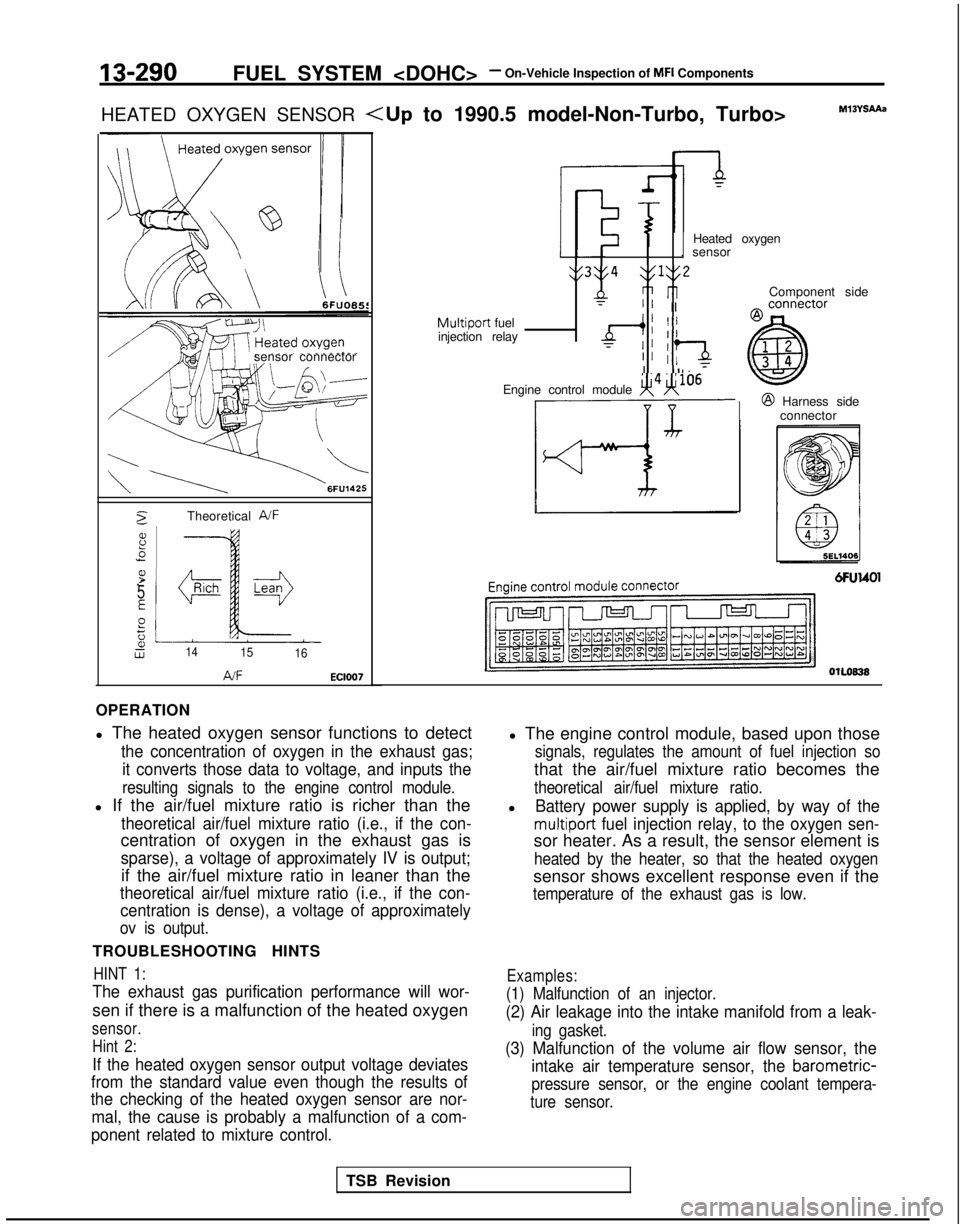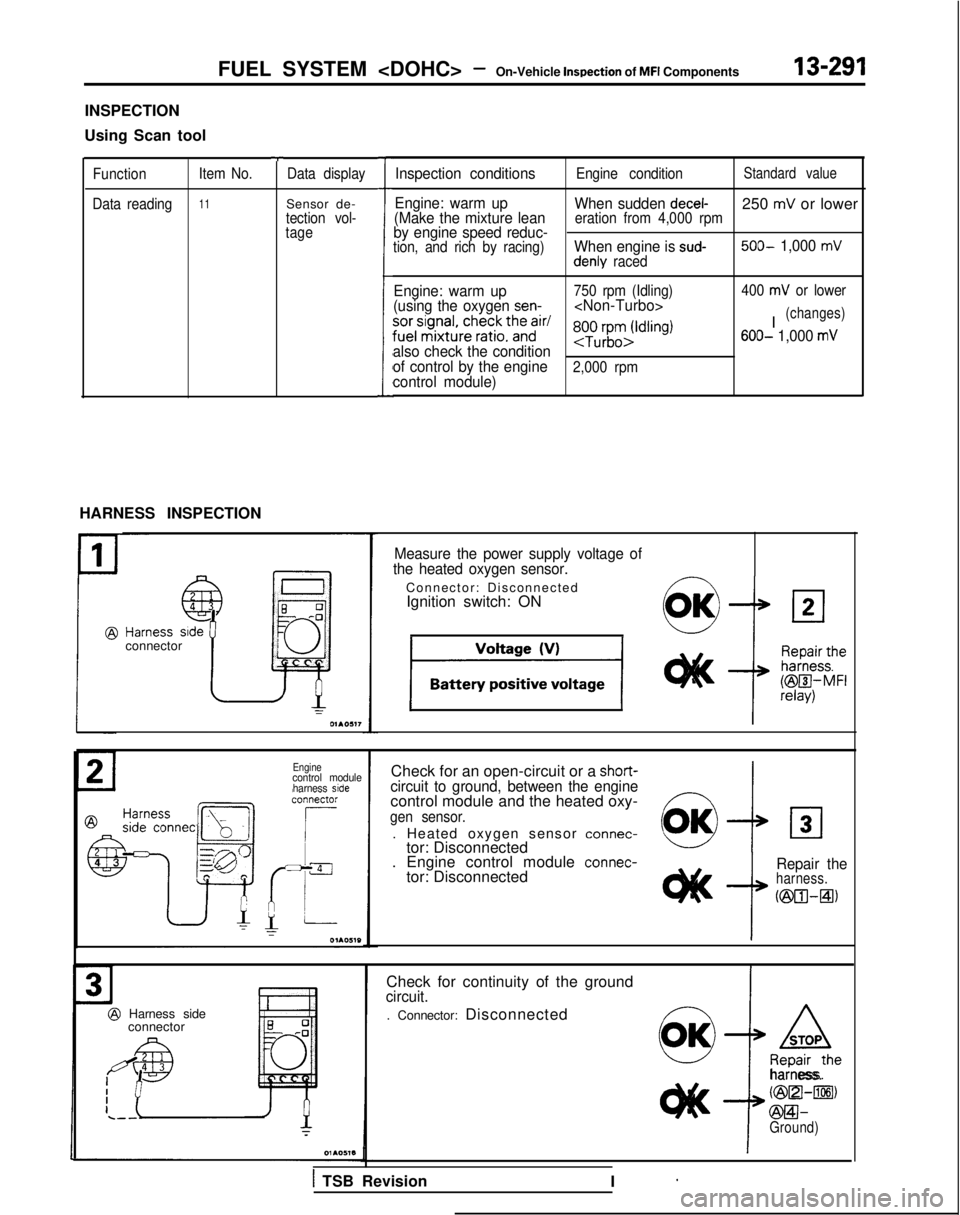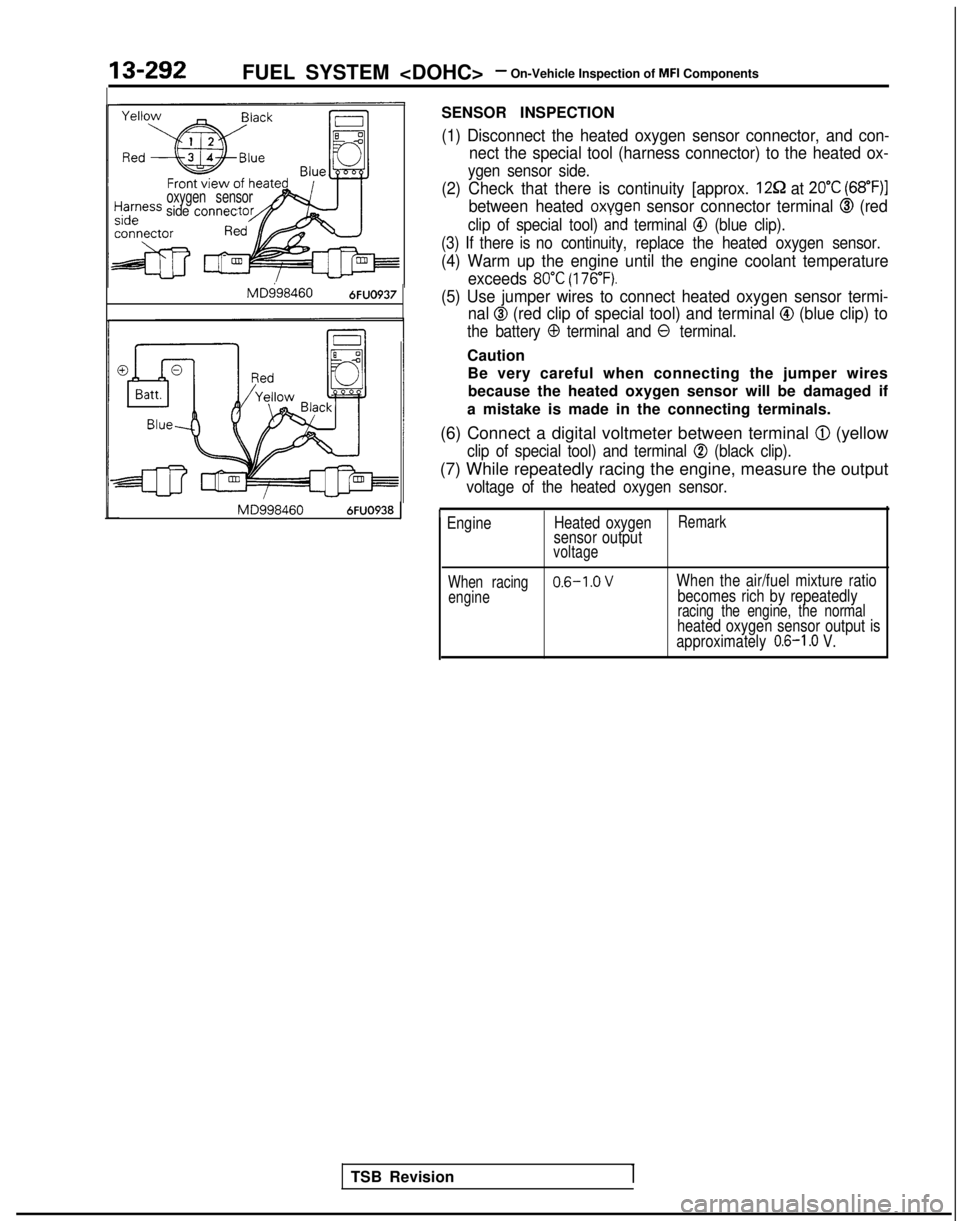Page 425 of 1273
FUEL SYSTEM -On-Vehicle Inspection of MFI Components
CRANKSHAFT POSITION SENSOR
[VI 1 Output characteristic
One rotation of crankshaft position sensor
01R0’03
Engine controlmqdule21
R5VJ7FUO499I
Multiport fuel
injection relay
@ Component sid
e
connector
MlBYhlABl
OPERATION
TROUBLESHOOTING HINTS
INSPECTION-Using Scan tool
INSPECTION-Using Oscilloscope
Refer to
P.13-281.
HARNESS INSPECTION
11 I
1’1
Measure the power supply voltage.
@Harness
side. Connector: Disconnected
connector Ignition switch: O
N
Voltage (VI
Battery positive voltage
-
7FUO496
Repair theharness.-+ (@a-Multi-port fuel in-jection relay)
TSB RevisionI
Page 426 of 1273
13-284FUEL SYSTEM - On-Vehicle Inspection of MFI Components
(
Check for continuity of the groundcircuit.
. Connector: Disconnected
7FUO497
Repair theharness.
* cm-Ground)
a Harness side connectorCheck the voltage of the output
cir- cut.
. Connector: Disconnected
. Ignition switch: ON
7FUOSOlL
IGNITION SWITCH-ST
Refer to P.13-77.
M13VNAAa
IGNITION SWITCH-ST AND PARK/NEUTRAL
POSITION SWITCHM13YOAc
Refer to P.13-78.
VEHICLE SPEED SENSOR
Refer to P.13-80.
M13YPAAa
POWER STEERING PRESSURE SWITCHM13VQAAa
Refer to P.13-81.
TSB Revision
Page 429 of 1273
FUEL SYSTEM -On-Vehicle Inspection of MFI Components 13-287
KNOCK SENSOR
M13zAAA
Engine control module
1 @ Component side
Oscillo
connector
I it’
ti hoc: !A!’ A2 II Isensor ! T1II
ISEL12081
@ Harness side
connector
OPERATION
The knock sensor converts cylinder block vibrations
due to knocking into voltage according to the
strength of the vibrations and inputs it to the engine
TROUBLESHOOTING HINTS When knocking occurs when driving at maximum load, the following troubles, other than the knock
control module.
The engine control module controls the delay in
spark timing according to this signal.
sensor, can be inferred. (1) Incorrect spark plug heat rating
(2) Incorrect gasoline
(3) Mis-adjustment of standard spark timing
Normal waveform 03A0205INSPECTION
Using Oscilloscope
(1) Connect the probe to the oscilloscope pick-up point as shown in the circuit diagram.
(2) Rev up the engine to 5,000 rpm, and check the waveform.
TSB Revision
Page 430 of 1273
12,7QQFI IFI GVSXFM - On-Vehicle lnmection
of MFI ComponentsId-LuvI “Lh V.V. h.1. .--..v-_.. .- .
connector Measure the terminal voltage.
. Connector: Disconnected
pf?q f$!?;
1 FU0513
Check for continuity of the ground
circuit.
. Connector: Disconnected
@p/LA
Repair the
harness.
KBB-Ground)
76FU1302
EGR TEMPERATURE SENSOR hn3m1
fiFU1424
Component side EGR temperature sensor
connectorI
1
. /
r
t-lA 17 A24 J
I
;
t
\15
Engine
control module
lrn5v
6FU1269
Harness side @
connector
!?ll
@lfiii
t?rl2 1 KL1202
ITemperature1521005
TSB Revision
Page 431 of 1273

FUEL SYSTEM -On-Vehicle Inspection of MFI Components13-289
OPERATION
l The EGR temperature sensor functions to con-
vert the data regarding the temperature of the
EGR gas downstream from the EGR valve to
voltage, and to input that voltage (as signals) to
the engine control module.
lThe 5V power supply within the engine control
module is supplied, by way of the resistance
within the unit, to the EGR temperature sensor;
it passes through the EGR temperature sensor,
which is a type of resistor, and is grounded at the engine control module.
Note that the resistance of the EGR tempera-
ture sensor decreases when the EGR gas vol-
ume increases and the temperature of the EGR
gas increases.
l The EGR temperature sensor terminal voltage
becomes higher when the resistance of the EGR
temperature sensor increases, and becomes lower when the resistance decreases.
Consequently, the EGR temperature sensor
terminal voltage varies in accordance with the
temperature of the EGR gas, becoming lower when the temperature of the EGR gas
in-
creases.
INSPECTION Using Scan tool
Function Item No.
Data reading
43
Data display 1 Inspection conditions1 Engine condition1 Standard valueI
Sensor. Engine: warm upIdling100°C (212°F) or lower
temoerature* Enaine is maintained in Ia &nstant state for 2
minutes or more
. Remove the vacuum
11 7J$lfifiF~ nr lower 1
hose (green stripes) fromthe EGR solenoid and3,500 rpm150°C (302°F) or higher/hlnn-Turbo>plug both the removed
vacuum hose end and
solenoid valve nipple.
HARNESS INSPECTION
Harness side
connector Measure the power supply voltage.
. Connector: Disconnected
. Ignition switch: ON
Voltage
(V)Repair the
Harness side
connector Check for continuity of the ground
circuit.
. Connector: Disconnected
SENSOR INSPECTION Refer to GROUP
l7-Exhaust Gas Recirculation (EGR) System.
Repair theharness.
@El-IIll. q l)
TSB Revision
Page 432 of 1273

13-290FUEL SYSTEM - On-Vehicle Inspection of MFI Components
HEATED OXYGEN SENSOR
M13YSAAa
sensor connector
2Theoretical A/F
8.5
P.-
5
E
Pt;2Lw1415 16
AJFEC1007
Component side
Heated oxygen
. sensor
y3y4 $1y2
nri rlT” IIMultiport fuel
injection relayd; II
TII :‘aII Il. 7
Engine control module x4H106@ Harness side
connector
OlLoB38
OPERATION
l The heated oxygen sensor functions to detect
the concentration of oxygen in the exhaust gas;
it converts those data to voltage, and inputs the
resulting signals to the engine control module.
l If the air/fuel mixture ratio is richer than the
theoretical air/fuel mixture ratio (i.e., if the con-
centration of oxygen in the exhaust gas is
sparse), a voltage of approximately IV is output;
if the air/fuel mixture ratio in leaner than the
theoretical air/fuel mixture ratio (i.e., if the con-centration is dense), a voltage of approximately
ov is output.
TROUBLESHOOTING HINTS
HINT 1:
The exhaust gas purification performance will wor-
sen if there is a malfunction of the heated oxygen
sensor.
Hint 2:
If the heated oxygen sensor output voltage deviates
from the standard value even though the results of
the checking of the heated oxygen sensor are nor-
mal, the cause is probably a malfunction of a com-
ponent related to mixture control.
l The engine control module, based upon those
signals, regulates the amount of fuel injection so
that the air/fuel mixture ratio becomes the
theoretical air/fuel mixture ratio.
lBattery power supply is applied, by way of the
multiport fuel injection relay, to the oxygen sen-
sor heater. As a result, the sensor element is
heated by the heater, so that the heated oxygen
sensor shows excellent response even if the
temperature of the exhaust gas is low.
Examples:
(1) Malfunction of an injector.
(2) Air leakage into the intake manifold from a leak-
ing gasket.
(3) Malfunction of the volume air flow sensor, the intake air temperature sensor, the
barometric-
pressure sensor, or the engine coolant tempera-
ture sensor.
TSB Revision
Page 433 of 1273

FUEL SYSTEM -On-Vehicle inspection of MFI Components13-291
INSPECTION
Using Scan tool
Function
Data reading Item No.
11
HARNESS INSPECTION
T
Data display
Sensor de-tection vol-
tage
L
Inspection conditionsEngine conditionStandard value
Engine: warm up When sudden decel-250 mV or lower(Make the mixture leaneration from 4,000 rpmby engine speed reduc-tion, and rich by racing)When engine is sud- 500- 1,000 mVdenly raced
Engine: warm up750 rpm (Idling)(using the oxygen sen-
~~~,s~~~r~hr~~i~t~~~ir’ 6JO;K~~ldling)
also check the condition
of control by the engine
2,000 rpmcontrol module)
400 mV or lower
I(changes) 600-
1,000 mV
connector
Enginecontrol module
harness side
@ ZTE-mector -La
@ El
4 3
-l
g;
@ Harness side
connector
Measure the power supply voltage of
the heated oxygen sensor.
Connector: Disconnected Ignition switch: ON
I II
Check for an open-circuit or a short-circuit to ground, between the enginecontrol module and the heated oxy-gen sensor.
. Heated oxygen sensor connec-
tor: Disconnected103
. Engine control module connec-tor: Disconnected
i
Repair theharness.
Nzm+l)
Check for continuity of the groundcircuit.
. Connector: Disconnected
@fR&eharness.
t
C@rzI-m,
@El-Ground)
1 TSB Revision I ’
Page 434 of 1273

13-292FUEL SYSTEM - On-Vehicle Inspection of MFI Components
Harnessoxygen sensorside connec
MD9984606FUO937
MD9984606FUO938
SENSOR INSPECTION
(1) Disconnect the heated oxygen sensor connector, and con-nect the special tool (harness connector) to the heated ox-
ygen sensor side.
(2) Check that there is continuity [approx. 1252 at 20°C (68”F)]
between heated oxygen sensor connector terminal @ (red
clip of special tool) and terminal @ (blue clip).
(3) If there is no continuity, replace the heated oxygen sensor.
(4) Warm up the engine until the engine coolant temperature
exceeds
80°C (176°F).
(5) Use jumper wires to connect heated oxygen sensor termi-nal
@ (red clip of special tool) and terminal @I (blue clip) to
the battery 0 terminal and 0 terminal.
Caution
Be very careful when connecting the jumper wiresbecause the heated oxygen sensor will be damaged if
a mistake is made in the connecting terminals.
(6) Connect a digital voltmeter between terminal
@ (yellow
clip of special tool) and terminal @ (black clip).
(7) While repeatedly racing the engine, measure the output
voltage of the heated oxygen sensor.
’ Engine Heated oxygenRemarksensor outputvoltage
When racing
0.6-1.0 VWhen the air/fuel mixture ratio
enginebecomes rich by repeatedlyracing the engine, the normalheated oxygen sensor output is
approximately 0.6-I .O V.
TSB Revision1